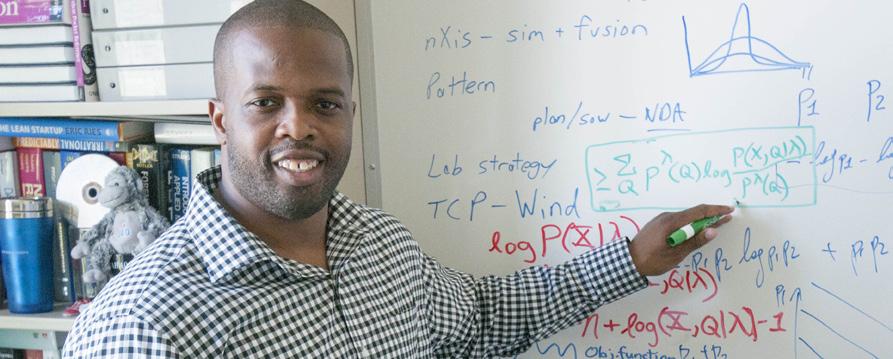
4 minute read
Career Voices
by Lango Deen ldeen@ccgmag.com J ames Gerard “Gerry” Lopez was still in kindergarten in the San Fernando Valley, California, when General Electric’s J. Stanford Smith put out a call to action in 1972. Smith wanted a tenfold increase in minority engineering graduates within 10 years.

James G. “Jerry” Lopez, Ph.D. Systems and Synthesis Lab GE Global Research
In response, the National Academy of Engineering (NAE) sponsored a symposium on increasing participation of minorities and women in engineering.
Two years later, the University of Notre Dame hosted a meeting of representatives from research centers, universities, and advocacy organizations to develop methods to increase representation and make sure everyone gets a chance.
Lopez attended California State University at Northridge and earned a bachelor’s degree in electrical engineering in 1988.
After that, he landed a great job at NASA’s Jet Propulsion Laboratory in Pasadena. The Jet Propulsion Laboratory (JPL) is the leading center for robotic exploration of the solar system
At the time, the JPL had a program where if you were working as an engineer you could go to the University of Southern California and get a graduate degree at no cost. So Lopez took advantage of his workplace benefits and earned his master’s in electrical engineering in 1990.
“I had no plans to continue on with my education,” Lopez recalled. “But through the Office of Academic Affairs at the Jet Propulsion Laboratory I came upon an opportunity that was offered to minority engineering students to get a Ph.D. at one of a number of colleges that were part of this program. It was called the GEM program.” Lopez applied and was accepted and also got accepted into the Ph.D. program at the University of Wisconsin in Madison.
“Through the GEM program I was able to complete my Ph.D., also in electrical engineering, but with a focus on fiber optics and lasers n 1999,” Lopez said.
“I owe that program a lot,” he added.” I probably would not have gone on to do my Ph.D. without them.”
“Engineers use data all the time. The thinking in the past was just
going through the data and finding what we were looking for. Big data
analytics is where you’re trying to get the data to tell you something
new. Something you didn’t know before. By necessity all of us at GE
have had to start thinking like data analysts and data engineers.”
— James G. “Jerry” Lopez, Ph.D.
––––––––––––––––––––DATA SCIENCE TEAMS 1. Spreadsheet users 2. Machine learning experts 3. IT and data engineers ––––––––––––––––––––
After his Ph.D., Lopez went on to work for a startup company outside Boston on high capacity fiber optic networks. When the telecom bubble burst in the early 2000’s he moved to General Dynamics working on another fiber optics program, gyroscopes, and project leadership. Then an opportunity came up almost nine years ago to join the staff at General Electric’s Global Research.
At General Electric, Lopez has been involved with projects that look at the machines that GE builds, such as aircraft engines and gas turbines that generate electricity and power our cities, and wind turbines.
“My role is to lead projects that develop technologies to make those machines work better, more efficiently, burn less fuel, produce more electricity and cost less for the customer,” he explained.
Through the course of developing those technologies and as GE has transformed itself from a physical to a digital industrial company, Lopez says he has had to understand more and more how

the data and analytics around those machines help us understand the operations of those machines and things about the machines electrical engineers might not know.
“Engineers use data all the time,” Lopez said. “The thinking in the past was just going through the data and finding what we were looking for,” he said.
“Big data analytics is where you’re trying to get the data to tell you something new,” Lopez added. Something you didn’t know before. ‘What can you tell me data that I didn’t think about before or didn’t quite understand about my machine before?
“By necessity all of us at GE have had to start thinking like data analysts and data engineers,” Lopez said.
Excel spreadsheets are not up to the job. To handle the massive amounts of data for analytics-driven companies such as GE are new tools that run in the Cloud like R. R, also called GNU S, is a programming language and has become the most popular language for data science and an essential tool for finance and statistical data.
Lopez cautions however that traditional engineering disciplines are still important, because students also have to understand the physics of the machine and how that works.
“What we’re trying to do is to combine the physics and analytics,” he said. “That’s where the whole digital industrial internet thing comes in and what’s going to make engineers of the future valuable” for solving global problems in power & water, oil & gas, energy management, aviation, transportation, and healthcare.
Lopez has a daughter who will soon graduate with a bachelor’s degree in biology and a highschool age son who hopes to study mechanical engineering.
If he were talking to his 20-year old self, Lopez said he would simply say “Dream big!”
Growing up in a poor neighborhood in the San Fernando Valley, Lopez said he had a very limited view of what he could be or what he could do. He certainly didn’t know what the Internet was.
“I was extremely fortunate to get a bachelor’s degree and a master’s and then the GEM opportunity,” he said. “At eighteen or nineteen, I didn’t always take the opportunities that were handed to me, because frankly I didn’t think I could dream that big,” Lopez said. S







